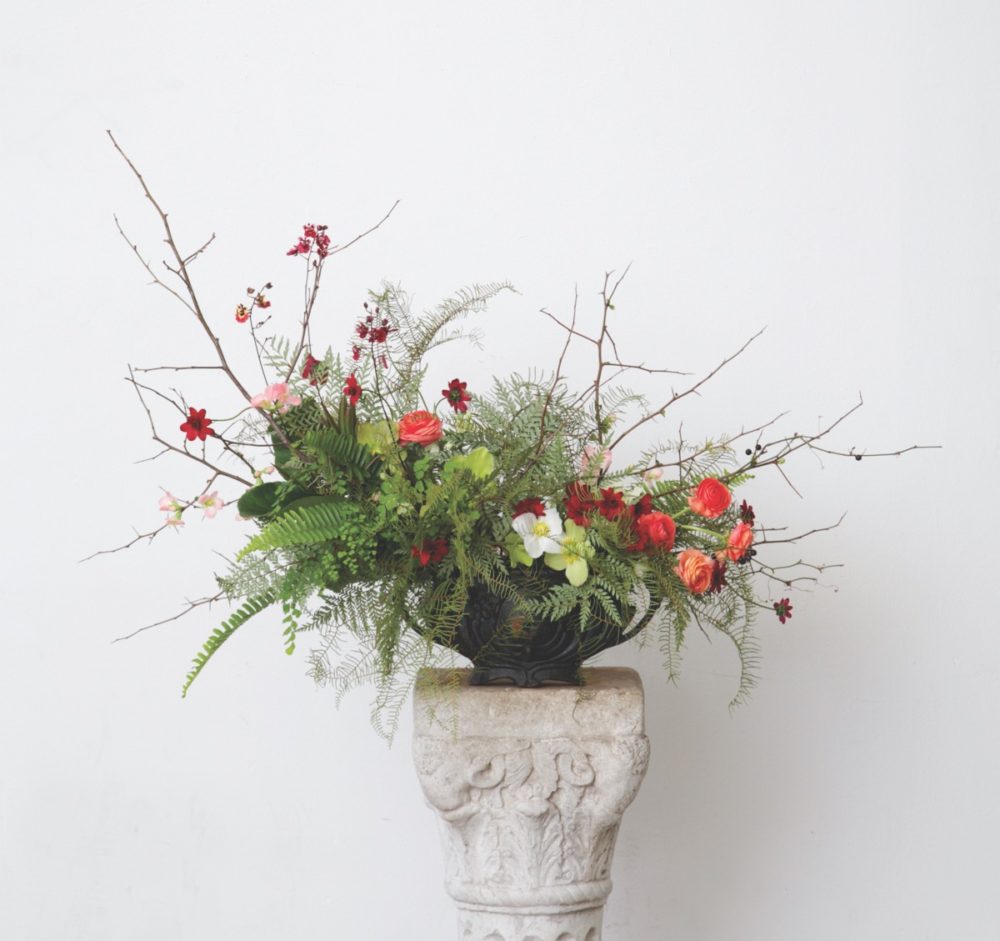
My inspiration for this design was a woodland scene. I like to think about the arrangement as a landscape in miniature. I imagine the flowers as rare sights, and you might have to part the undergrowth to find the specimens. The flowers and color are the punctuation to what is primarily the study of the forest floor. I like the blooms to nestle in the base, and then float around the periphery. Here I matched delicate with delicate, with no dominant, large-scale petals.
 Materials
Materials
- corydalis fern
- maidenhair fern
- sea star fern
- ‘Chili’ leatherleaf fern
- paperwhites
- ranunculus
- chocolate cosmos
- quince
- hellebores
- alocasia foliage
- tolumnia orchids
 Tools & Supplies
Tools & Supplies
- cast iron container
- floral tape
- shears
- wild smilax vines
 1| Place the wild smilax vines (birch works well, too) in a nest inside the vessel to create a structure for your stems.
1| Place the wild smilax vines (birch works well, too) in a nest inside the vessel to create a structure for your stems.
 2| Tape a grid over the vines to hold them inside the vessel. Then tape around the perimeter of the container to secure the grid.
2| Tape a grid over the vines to hold them inside the vessel. Then tape around the perimeter of the container to secure the grid.
 3| Now it’s time to add the quince. With any woody branches like these, crosscut the stems so they can take in water more easily.
3| Now it’s time to add the quince. With any woody branches like these, crosscut the stems so they can take in water more easily.
 4| When adding the quince, place the largest branches first to begin to create a shape.
4| When adding the quince, place the largest branches first to begin to create a shape.
 5| Next, add the different types of ferns. Placing the larger foliage first, such as this sea star fern, allows your arrangement to take form.
5| Next, add the different types of ferns. Placing the larger foliage first, such as this sea star fern, allows your arrangement to take form.
 6| Looking to plants for cuttings allows for a much broader range of materials than just using cut flowers. Cut the hellebore stems low to the base of the plant so you have more stem to work with. Then add them to the arrangement.
6| Looking to plants for cuttings allows for a much broader range of materials than just using cut flowers. Cut the hellebore stems low to the base of the plant so you have more stem to work with. Then add them to the arrangement.
 7| Continue to add elements in this basic white and green palette, such as fragrant paperwhite.
7| Continue to add elements in this basic white and green palette, such as fragrant paperwhite.
 8| Add some color with watermelon ranunculus in groupings. Then place the delicate red chocolate cosmos floating above the arrangement on its tiny stems.
8| Add some color with watermelon ranunculus in groupings. Then place the delicate red chocolate cosmos floating above the arrangement on its tiny stems.
 9| Carefully remove the tiny tolumnia orchids from their pots.
9| Carefully remove the tiny tolumnia orchids from their pots.
 10| Finally, gently place the orchids within the arrangement with their roots intact. After the cut flowers in this design have faded, these orchids can be repotted.
10| Finally, gently place the orchids within the arrangement with their roots intact. After the cut flowers in this design have faded, these orchids can be repotted.

“The season brings such delicate and fragile materials, so seductive in their vulnerability and tiny scale. This kind of arrangement is a lovely way to greet the unpredictability of the spring weather. I love the slight danger that one of April’s gusts could carry the entire piece away.” –EMILY THOMPSON
Produced by Abby Braswell
Photography by Brooke Slezak
More Step-by-Step Floral Arrangements
- Pretty in Pink with Tara Guérard
- Tropical Twist with Lesley Frascogna
- Giverny Greens: A French Monochromatic Arrangement
